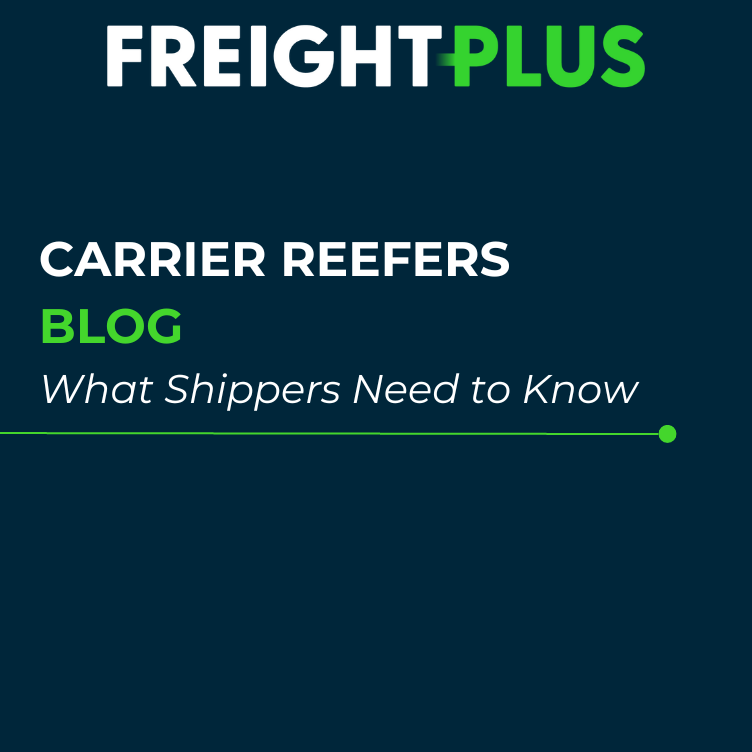Introduction
In the world of shipping, the term “carrier reefer” holds significant importance, especially for shippers dealing with temperature-sensitive cargo. Understanding carrier reefers and their role in logistics is essential for shippers who want to ensure the safe and reliable transport of their goods. This blog explores the world of carrier reefers and provides shippers with the knowledge they need to navigate this vital aspect of shipping.
What are Carrier Reefers?
Defining Carrier Reefers
A carrier reefer, short for refrigerated container, is a specialized container used for transporting goods that require temperature control during transit. Unlike standard shipping containers, carrier reefers are equipped with refrigeration and climate control systems, making them indispensable for shippers dealing with perishable or temperature-sensitive cargo.
Types of Carrier Reefers
Exploring Reefer Types
Carrier reefers come in various types, each designed to meet specific shipping requirements:
- Containerized Reefers: These are reefers integrated into standard shipping containers, offering versatility and compatibility with container ships, trucks, and trains.
- Trailer-Mounted Reefers: These reefers are mounted on trailers and are commonly used for land-based transportation.
Understanding the different types of carrier reefers allows shippers to choose the most suitable option for their cargo and transportation needs.
Temperature Control and Monitoring
The Heart of Reefer Technology
Temperature control is the heart of any carrier reefer system. These containers rely on advanced technology to maintain a consistent temperature throughout the shipping journey. The precise control and monitoring of temperature are crucial to ensure the integrity of sensitive cargo, such as pharmaceuticals, fresh produce, and chemicals.
Key Features and Components
Components Explained
Carrier reefers are equipped with various components to maintain temperature and cargo integrity. Some key features include:
- Compressor: Responsible for cooling the air inside the reefer.
- Evaporator: Distributes cold air evenly throughout the container.
- Condenser: Releases heat generated during the cooling process.
- Humidity Control: Maintains the desired humidity levels.
- Ventilation: Ensures proper airflow within the container.
Understanding these components is essential for shippers to grasp how carrier reefers work and how to troubleshoot issues if they arise.
Carrier Reefer Load Planning Best Practices
Tips for Effective Load Planning
Shippers must master the art of loading cargo into carrier reefers effectively. Proper load planning ensures even distribution of temperature-sensitive goods, reducing the risk of spoilage or damage during transit. Key tips for successful load planning include:
- Accurate Cargo Weight and Volume Calculation: Avoid overloading or underloading the reefer.
- Strategic Positioning: Place temperature-sensitive items strategically within the container, considering their specific temperature requirements.
- Airflow and Insulation: Ensure proper airflow and insulation to maintain a consistent temperature environment.
- Cargo Securing: Use appropriate restraints to prevent cargo from shifting during transit.
Carrier Reefer Maintenance and Inspection
Ensuring Reefer Reliability
Routine maintenance is crucial to keep carrier reefers in optimal condition. Shippers should conduct regular inspections to identify and address potential issues. Common maintenance tasks include:
- Cleaning and Defrosting: Keeping the reefer clean and frost-free.
- Checking for Leaks: Inspecting for refrigerant leaks.
- Testing Temperature Controls: Ensuring the temperature controls function as intended.
- Inspecting Gaskets and Seals: Checking for wear and tear on seals to maintain a proper seal.
Compliance and Regulations
Navigating Regulations
Carrier reefers must adhere to specific regulatory standards and certifications to ensure the safe transport of goods. Shippers should be aware of these regulations to avoid legal issues and ensure cargo safety.
Collaborating with Reefer Carriers
Successful Partnerships
Successful reefer shipments require effective collaboration between shippers and carrier companies. Clear communication and coordination are essential to ensure cargo is handled with care and transported at the required temperature.
Future Trends in Carrier Reefers
Staying Ahead of the Curve
The world of carrier reefers is continually evolving. To stay ahead in the shipping industry, shippers should keep an eye on emerging trends, including:
- Sustainable Refrigeration Technologies: The rise of eco-friendly refrigeration options.
- Smart Reefer Monitoring and IoT Integration: Real-time monitoring for enhanced cargo visibility.
- Reefer Container Size and Flexibility: Containers with adjustable temperature zones.
- Cold Chain Digitization: Data-driven insights for improved efficiency.
- Reefer Safety and Security: Advanced security features and practices.
- Customized Reefer Solutions: Tailored solutions for specific industries.
- Cold Chain Visibility and Transparency: Improved end-to-end visibility.
Navigating the World of Carrier Reefers
Understanding carrier reefers is paramount for shippers dealing with temperature-sensitive cargo. When shippers can navigate the complexities of carrier reefers, ensuring the safe and reliable transport of their valuable goods, they can stay ahead of the curve and gain a competitive advantage in the temperature controlled shipping market.
For Shippers
Are you looking to connect with a sales representative?



